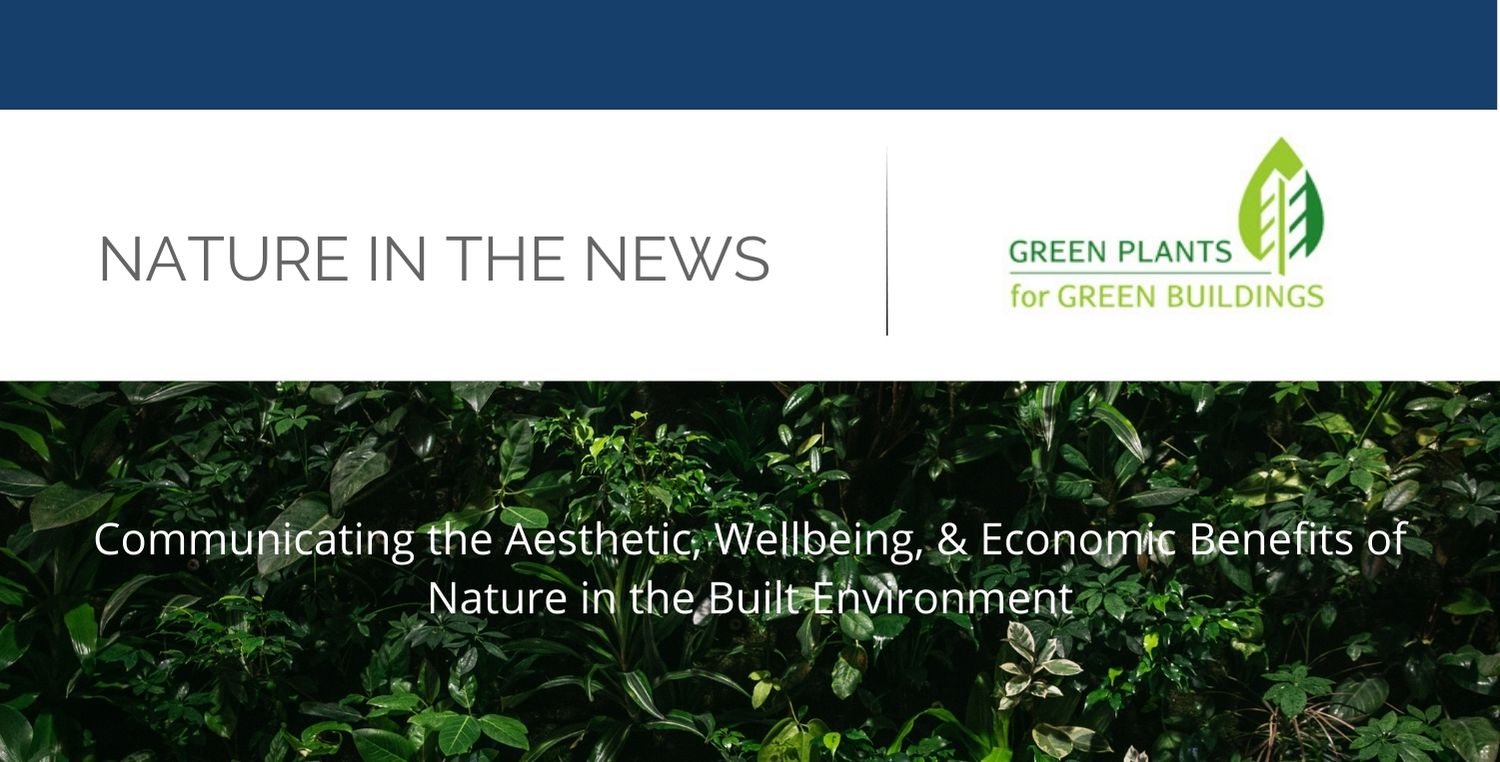
This e-newsletter brings you the latest information and resources on biophilic design, the industry, and GPGB updates.
What’s biophilia, and what role should it play in your HR Strategy?

Photo: Intuit, Holmes Portfolio
Article: HR Brew By Kristen Parisi, April 17, 2024 · 4 min read
Incorporating nature into office design can help increase productivity and creativity, research finds.
There’s something about nature and fresh air that makes people feel happier and more relaxed…until a spider crawls up their leg. Then it’s game over and back to the great indoors.
Regardless of the occasional rogue arachnid, people generally like having a connection to nature, and some experts believe that experience should be brought into the office.
Get down with biophilia. If you’re not familiar, the term biophilia was coined in the 1960s and describes the desire to be close to nature, according to Merriam-Webster.
…HR’s green thumb. Intuit’s new Mountainview, California offices, which opened in January, feature biophilic elements, Michael Merola, VP of places at Intuit, recently told HR Brew. He said that the company spent a lot of time developing the street-level landscaping and building terraces to create an inviting office. “I have found myself using those spaces and I have looked out and seen people out there [on the terraces] on phone calls,” he said. The company’s campus incorporates plants native to the area, outdoor water features, and a green wall that hosts more than 4,000 living plants. The company also weaves greenery throughout the meeting spaces, staircases, and curated outdoor spaces that make up its 178,600 sq ft campus.
As HR leaders think about the employee experience and well-being, Engels and Merola believe they should consider nature and how incorporating it into offices can make work a place employees are drawn to. “At the end of the day, they’re really about humans,” Engels said. “And how their people are growing. How they’re thriving at work. It is a correlation between the ask and what their mission is.”
Urban Terrarium: Only Architect-Landscape Architect Collaboration Can Truly Delivery Biodiversity

Photo: Sectional drawing of ‘urban terrariums’ in Sierra Sathorn
by Redland-scape.LTD, Bangkok, Thailand
Blog: Architizer
By Martin Guttridge-Hewitt
We still need to level the playing field between external environmental design and structural blueprints.
…Redland-scape.LTD’s addition to this melting pot completed in 2022. Amid a densely residential area dominated by mid and high rises properties, the firm has created what it describes as an “urban terrarium prototype” based on the natural relationships between mountainous, woodland and river ecosystems. Having repurposed a podium structure, these environments are spread over the foot and mezzanine levels of a huge condominium. Mid-height and rooftop gardens also feature, installed into the fabric of the building itself, incorporating open greening, sports and recreational areas, swimming pools, and a sky forest. The emphasis is on (re)introducing a breadth of flora and fauna to reflect the heterogeneity of South East Asia’s rich wildernesses…
Exclusive Speaking Sessions w/GPGB at AIA24

Ready to dive deeper into the world of biophilic design?
Join us at the The American Institute of Architects Conference 2024.
We’re passionate about integrating nature into our living and working spaces, enhancing aesthetics, and fostering a deep connection between humans and nature.
Visit us at Booth #643, opposite the Puppy Park, to discover how incorporating natural elements can transform architectural design.
Your Investment At Work

GPGB IS A GOLD SPONSOR AT AIA24 AND WILL HAVE AN ENORMOUS PRESENCE WITH A JAW-DROPPING BOOTH, EXPERT INDUSTRY SPEAKERS, AND MORE…
➡️ Don’t miss out on this amazing opportunity to have YOUR company recognized at AIA24. Ensure your GPGB support is active and/or level-up today!
Find details in the Call to Action: Support and/or “Level-Up” with GPGB below.
Call to Action: Support and/or “Level-Up” with GPGB

Our purpose is to communicate the aesthetic, wellbeing, and economic benefits of nature in the built environment.The target audience is the commercial specifier, building owner, facility manager and related decision makers.
Thanks to our supporters, we have been extremely successful in reaching our audience. In 2023, there is unparalleled awareness of the economic benefits of interior plants and more plants are being specified in building projects than ever. The industry has never been stronger. We want to capitalize on our momentum and assure plants become a permanent element in commercial design.
GPGB is asking for increased support. GPGB has just completed an overhaul of our supporter tiers and added new benefits at each level. As important as the benefits are, the primary reason to support is to help us influence more decision makers on the benefits of plants, and ultimately grow the industry, and grow your business.
Thank you to the following companies for “leveling-up” with GPGB:
Continued Education Units

Educate, Advocate, and Empower with GPGB courses!
It is increasingly well documented that biophilic elements such as live plants in buildings have measurable benefits to productivity, emotional wellbeing, stress reduction, and improved learning and healing.
The inclusion of biophilic design elements into building standards (the WELL Building Standard, Fitwel, the Living Building Challenge, LEED) is creating an even greater need for biophilic design information.
As part of GPGB’s core purpose is communicating the aesthetic, wellbeing, and economic benefits of nature in the built environment, we create courses credentialed for continuing education credit by the professional organizations listed below.
These courses contain important research-based information about the biophilic design ethic’s contributions to human health, safety, and welfare, as well as practical information about how to specify indoor nature in the built environment.
Volunteers Wanted for Committees and Board of Directors
GPGB depends on the work of volunteers to carry out our strategic initiatives and fulfill our mission. Serving on a committee or as a GPGB board member is a rewarding experience and an opportunity for personal and professional growth. If you can make a minimum two-year commitment, the industry needs people like YOU!
- Marketing & Communications
- Supporter Development
- Education & Professional Development
Thank You to Our Supporters!
GPGB is making a difference and it’s all thanks to our valued supporters. Our supporter’s participation and contribution is greatly appreciated not only by us, but by everyone in the industry.
Thank you for continuing to add your voice to the hundreds of other industry professionals committed to integrating plants into our built environments. We appreciate your understanding and willingness to “Level-Up” this year!
Continued Supporter Call To Action: Please continue to add your reels, shorts, stories, and all other 15-30 second videos related to biophilia here in order to be featured on GPGB social media.
Biophilic Gallery

Credit: Design Boom
Vertical Garden by Yasushi Okano
The Brutalist Plants book, penned by Olivia Broome, offers a captivating exploration of the fusion between brutalist architecture and lush vegetation. Published by Hoxton Mini Press, the monograph showcases over 150 evocative images by diverse photographers, capturing the juxtaposition of austere concrete structures and vibrant flora. The book serves as a tangible extension of its renowned Instagram counterpart, Brutalist Plants (@brutalistplants), which shares a diverse array of architectural projects worldwide, from angular terraces adorned with creeping vines to moss-laden cracks resembling natural arteries, and vividly illustrates nature’s reclaiming of urban landscapes.

Photo and Credits: GreenRoofs.com
One Central Park Sydney living wall facts:
– 350 different species of plants used in the green walls alone
– 35,000 green wall plants
– 85,000 facade plants in total
– 23 green walls = 1200 sqm total
– Largest green wall is in the East Tower = 196 sqm
– 5,500 planter boxes surround every level of the East and West Towers and five levels of the retail podium
– 15km of 4mm diameter stainless steel cables used across the project
– 2,100 stainless steel springs used to keep vine cables tensioned
– 2,486 glass façade panels on the East Tower = 12,678 sqm of glass
– 820 glass façade panels on West Tower = 4,428 sqm of glass
Total area of glass on both towers = 17,106 sqm x 12.5mm thickness x 2.5kg/mm = 534.5 tonnes of glass.
Want to Help Keep Nature in the News?
 Everything we accomplish happens because people like you are stepping forward and supporting GPGB’s focus on having conversations with the building professionals who can #BringNatureIndoors.
Everything we accomplish happens because people like you are stepping forward and supporting GPGB’s focus on having conversations with the building professionals who can #BringNatureIndoors.
If the spirit moves you, please consider supporting our work by making a donation.
